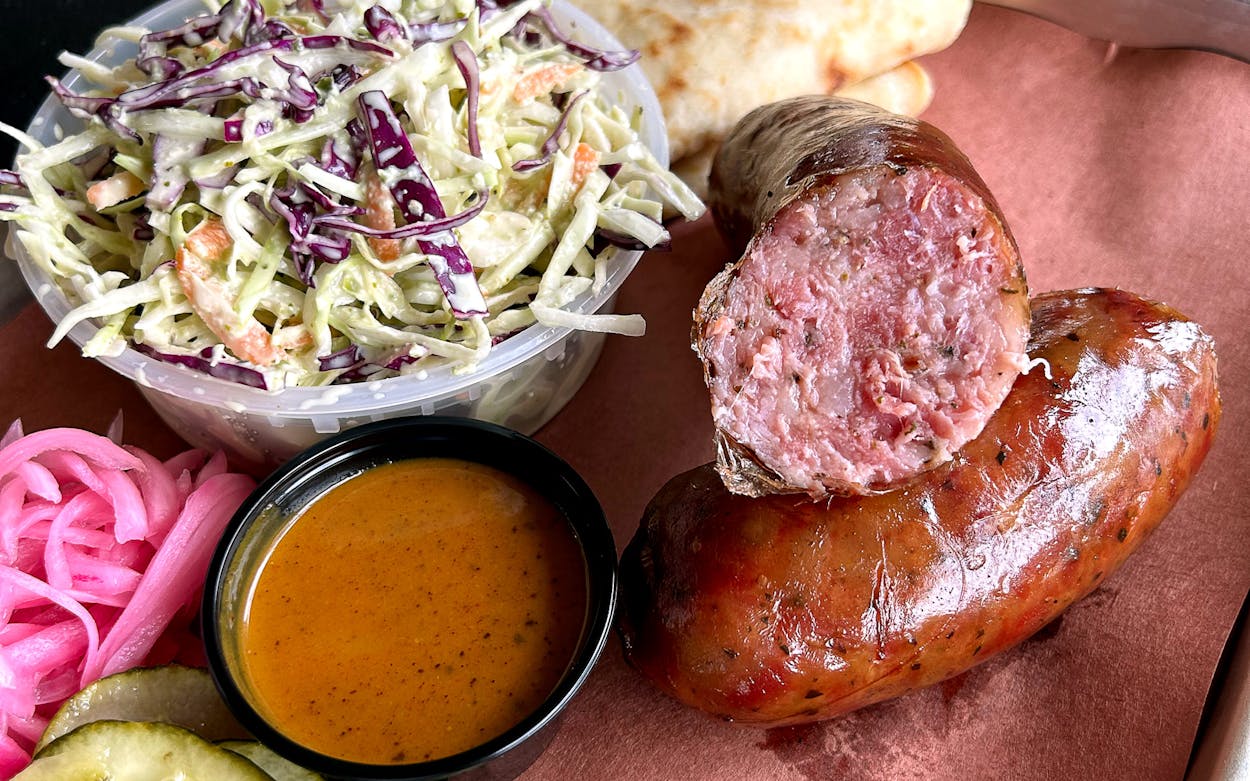At InterStellar BBQ, outside Cedar Park, owner John Bates has just begun a year-long exploration into the roots of Texas barbecue sausages. He first chose to survey the origins of Polish sausage in Texas, and he is now serving the first in a series of kielbasas through the end of April. When I asked Bates to describe it, he said, “I hope this represents what a Polish immigrant might have been trying to make when he got to Texas.”
“Kiełbasa” in Polish simply means “sausage.” There are many different varieties of kielbasa that vary in protein, seasoning, coarseness, casing type, and preparation. Bates developed InterStellar’s version based on kiełbasa wędzona, an all-pork Polish smoked sausage. He studied historical recipes to find a classic style with simple ingredients. Bates also referred to Polish Sausages: Authentic Recipes and Instructions, a book from 2009 by Stanley and Adam Marianski and Miroslaw Gebarowski.
In the book, the authors describe how the Polish government codified the recipes for different sausage varieties in 1959 in the provocatively titled Internal Regulations #16 for Making Meat Products and Sausages (a 1964 update replaces “#16” with “#21″ in the title). They reproduce the recipes in the book, and Bates mostly stayed true to their kiełbasa wędzona, which includes salt, black pepper, marjoram, garlic, and a little sugar. “Without garlic, you can’t call it a Polish sausage,” Bates said. He also added paprika based on his research of other spices common in both Poland and Texas. Bates will also use those official government recipes to produce kiełbasa czosnkowa, heavy with fresh garlic, in May.
I love a coarse grind, and the sausage at InterStellar takes it to the extreme. I sat with Bates as I snapped into a link, and boy, did it snap. Chunks of lean meat and soft fat were so distinct in the cross section, I wondered if the filling had been chopped by hand. Bates said he used a grinding plate with thirteen-millimeter holes, instead of the five- to seven-millimeter grinding plates he normally uses. The sausage is all pork, with a blend of fatback, pork belly, and trim from pork shoulders going into the mix. “It’s rowdy,” Bates said, but it’s really no fattier than most of the beef sausages in Texas. Enjoying the flavor of pork without added chiles, cheese, or other adulterations made me wish for this old recipe to become a new trend.
When Bates announced the sausage special on social media, he got some pushback saying that Czechs, not Poles, deserve all the credit for Texas-style smoked sausages. Bates promised that after a few months of exploring Polish sausages, he would conduct similar studies on German and Czech sausages. I would also note that Panna Maria was founded in 1845 as the first Polish settlement in the country. The Germans first settled in Industry in the 1830s, and Czech immigrants arrived en masse at Cat Spring starting in 1852. All of them brought along their sausage traditions, which helped build the style of Central Texas barbecue we still enjoy today.
I chronicled my search for both Czech sausages and German-style sausages in Texas a decade ago. They’re more prevalent in the state than their Polish cousins, so I was glad to see Bates take such an interest in kielbasa history. He said his family has been in Texas for nearly two hundred years, so it was time to look more deeply into the history and understand where his barbecue fits in. “I felt like if I was going to continue to push barbecue forward, I need to make sure I have well-grounded roots looking backwards,” Bates said.
When Bates opened InterStellar, just five years ago, it was as avant-garde as Texas barbecue joints got. Bates was imitating the experimentation that preceded him around the state when developing InterStellar’s signature peach tea–glazed pork belly and jalapeño-popper sausage as well as sides such as citrus-beet salad and smoked scalloped potatoes. Bates went full speed ahead trying to outdo the competition, and he quickly turned the restaurant into the number two barbecue joint on our most recent Top 50 list. Now it’s time to slow down and reflect on the building blocks he may have overlooked, which is uncommon for a pitmaster with his success.
And that’s refreshing. As I polished off the last of my link, he said, “As much as I want this be representative of a modern barbecue joint moving forward, I don’t want to forget where it comes from.”








